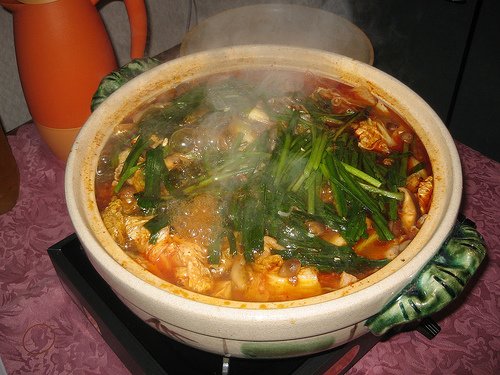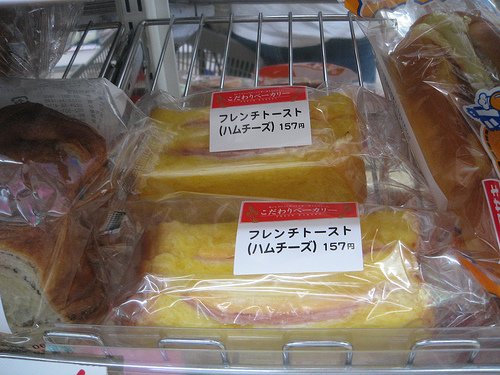Last night we went to a friend’s house to have one of my favorite dishes, nabe (NAH-beh), a word that just means “pot” and refers to any kind of food you make in a big open pot and eat with everyone gathered around, conversing while taking things out (boiled meat, fish, tofu, vegetables, etc.). There are many varieties of nabe, from the spicy Kimchee Nabe that our friends made for us last night (as they are wont to do, the Japanese have adopted the national food of Korea as one of their own) to the Kiritanpo variety enjoyed in Northern Japan, and the famous Chanko Nabe from Nagasaki, huge pots containing many different ingredients which are traditionally eaten by sumo wrestlers. Another famous variety of nabe food is Sukiyaki, one of my all-time favorite dishes. Aside from being delicious and a great way to warm up in the colder months, nabe is a genuine “social food” which makes for great conversation, since everyone sits around the pot to take food out of it rather than eating from their own hoarded pile. It also allows uniquely Japanese concepts like enryo, the tendency for people hesitate when taking, say, the last piece of tofu before asking of anyone else would like it, to work in the group. (We do have some great bilingual books on how to make Japanese food like nabe, although most are out of stock due to their popularity. You can backorder any of them and we’ll send the when they come in.)

One sad aspect of Japan’s society is ijime (ee-jee-MEH), the cruel bullying that happens in school and other situations. We’re all human, of course, and various forms of hazing can be found in any group, from college fraternities to West Point to making the new guy at McDonald’s count all the pickles in the pickle bucket as an initiation ceremony. There are some reasons why ijime is an especially bad problem in Japan, including the strictness of the top-down senpai-kohai relationship system and the practice of having students sit in the same class with the same members for an entire year rather than giving each student a different hourly schedule, which means that any problem between students is magnified many times. You can see examples of ijime in Japanese animation stories, too, such as the classic tennis show Aim for the Ace, which is closely parodied by Gainax’s Aim for the Top: Gunbuster (which we have paid no small tribute to). When the main character is chosen for the tennis team even though she barely knows how to hold a racquet, she becomes the target of teasing by the other members, who do things like put thumbtacks in her shoes. Of course, ijime can happen to anyone, and my wife even had problems with some of her co-workers at a company she used to work at. Once, everyone was going out to eat at a French restaurant, and they told her to dress in plain clothes. When she arrived in jeans, she saw that everyone else had secretly dressed up, just to embarrass her. Sad to say, but my half-American daughter has been the target of ijime in her almost-homogenous school from time to time, for example when the other girls cruelly say “What’s that? I can’t understand English” when she speaks to them in Japanese. We make sure we’re supportive and let her know she shouldn’t pay any attention to what some silly kids say. She is Japanese, and American, and has both passports to prove it.
When you learn a foreign language, the first thing you usually learn are the “naughty” words. However, people studying Japanese are often surprised to learn that most of the bad words they’re used to in English don’t “map” over very well. The most common Japanese insults include baka (BAH-kah, stupid), aho (ah-HO, the Osaka version of the same word), and boke (BOH-kay, basically meaning “nim-wit”). Almost all the anatomical words you may be used to just don’t work in Japanese, nor does the “F” word, which doesn’t even exist, except occasionally in English as a foreign loan word. The most basic Japanese swear word is probably kuso (KOO-soh), the “s” word, yet it’s interesting to note that it’s not considered a bad word, as it’s used in children’s anime like Yu-Gi-Oh quite often and no one thinks anything of it. It addition to the primary meaning, the word kuso can also refer to various bodily products. The stuff that comes out of your nose is hana-kuso (nose-sh–), and ear wax is mimi-kuso (ear-sh–). Sleep in your eyes that builds up while you sleep is me-kuso (MEH-kuso), and plaque on your teeth is called ha-kuso. Now you know some interesting Japanese vocabulary words!
Good news for fans of our Japanese calendars: we’ve gotten in a huge shipment of our most popular 2007 anime, JPOP, idol/actress, traditional, art and other calendars, and we’ve posted them to the site, complete with updated photos so you can see how good the insides of these calendars are. There’s no better way to spend the coming year than with a slice of Japan on your wall. Since J-List goes far behind carrying merely the top 20-25 releases, instead carrying a huge selection of these great poster-sized glossy calendars, you’ve got a huge selection to browse through while you decide which you’d like to by. But fair warning: our current stock represents the last stock we’ll get of many calendar items, so we recommend that you order sooner, rather than later, to avoid the agony of not getting that Ghibli or Domo-kun calendar you had your eye on disappearing from the site.
J-List would like to remind you that we’ve got a huge selection of cool and wacky products from Japan, which would make great gifts for the anime fan or general Japan-lover on your Christmas list this year. If you’re wondering what to get the anime fan on your list who has everything, we’re sure we’ve got some great products, from our above-mentioned calendars to great toys and Totoro blankets and wacky T-shirts and our patented “wacky things from Japan.” It is of course best to buy early so you can take advantage of cheaper shipping — why not browse the site and make your order now?















